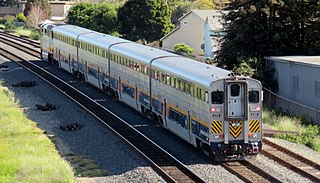
The San Joaquins is a passenger train service operated by Amtrak in California's San Joaquin Valley. Six daily round trips run between its southern terminus at Bakersfield and Stockton, with onward service to Sacramento and Oakland.

The Tehachapi Loop is a 3,779-foot-long spiral, or helix, on the Union Pacific Railroad Mojave Subdivision through Tehachapi Pass, of the Tehachapi Mountains in Kern County, south-central California. The line connects Bakersfield and the San Joaquin Valley to Mojave in the Mojave Desert.

Tehachapi Pass is a mountain pass crossing the Tehachapi Mountains in Kern County, California. Traditionally, the pass marks the northeast end of the Tehachapis and the south end of the Sierra Nevada range.

California High-Speed Rail is a publicly funded high-speed rail system currently being developed in California in the United States. In 1996, the California Legislature and Governor Pete Wilson established the California High-Speed Rail Authority with the task of creating a plan for the system and then presenting it to the voters of the state for approval. In 2008, voters approved the plan given in Proposition 1A, which specified a route connecting all the major population centers of the state, authorized the issuance of bonds for beginning implementation, and established other requirements.

Central California is generally thought of as the middle third of the U.S. state, of California, north of Southern California, which includes Los Angeles, and south of Northern California, which includes San Francisco. It includes the northern portion of the San Joaquin Valley, part of the Central Coast, the central hills of the California Coast Ranges and the foothills and mountain areas of the central Sierra Nevada.

The San Joaquin Valley Railroad is one of several short line railroad companies and is part of the Western Region Division of Genesee & Wyoming Inc. It operates over about 371 miles (597 km) of owned or leased track primarily on several lines in California's Central Valley/San Joaquin Valley around Fresno and Bakersfield. The SJVR has trackage rights over Union Pacific between Fresno, Goshen, Famoso, Bakersfield and Algoso. The SJVR also operated for the Tulare Valley Railroad (TVRR) from Calwa to Corcoran and Famoso.
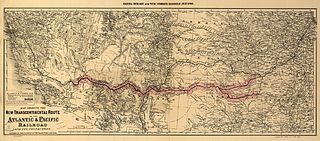
The Atlantic and Pacific Railroad was a U.S. railroad that owned or operated two disjointed segments, one connecting St. Louis, Missouri with Tulsa, Oklahoma, and the other connecting Albuquerque, New Mexico with Needles in Southern California. It was incorporated by the U.S. Congress in 1866 as a transcontinental railroad connecting Springfield, Missouri and Van Buren, Arkansas with California. The central portion was never constructed, and the two halves later became parts of the St. Louis-San Francisco Railway and Atchison, Topeka and Santa Fe Railway systems, now both merged into the BNSF Railway.

The Santa Fe Passenger Depot, also known as Fresno station, is an historic railroad station and transportation hub in downtown Fresno, California. It is served by San Joaquins inter-city passenger trains, Greyhound inter-city buses, and regional transit services including Fresno Area Express and the Fresno County Rural Transit Agency.

The Martinez subdivision is a Union Pacific railway line which runs from Roseville, California to Oakland, California. It is informally referred to as the Cal-P line, after the original California Pacific Railroad, who constructed the line from Sacramento to Suisun and Fairfield. The line is entirely double-tracked including bridges, and features extensive sidings.

The Southern Transcon is a main line of BNSF Railway comprising 11 subdivisions between Southern California and Chicago, Illinois. Completed in its current alignment in 1908 by the Atchison, Topeka and Santa Fe Railway, when it opened the Belen Cutoff in New Mexico and bypassed the steep grades of Raton Pass, it now serves as a mostly double-tracked intermodal corridor.

Kern County’s transportation system was quoted as the “unseen industry.” Located at the southern end of the San Joaquin Valley, the county is at a prime location to ship goods west to the central coast, south to ports in Los Angeles, and east to corridors that connect to the rest of the country. It is also on major corridors that link to all northern points.
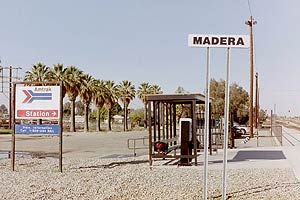
Storey was an unstaffed train station located in the unincorporated community of Storey, and about 1 mile (1.6 km) southeast of the Fresno River, in Madera County, California, United States. Just prior to its closure in November 2010 and replacement by the new Madera station, this station was served by Amtrak's San Joaquin. Prior to Amtrak, this station was also previously served by Atchison, Topeka and Santa Fe Railroad's (ATSF) San Francisco Chief and its Oakland-Barstow Line.
Merced station is a proposed California High-Speed Rail station in Merced, California, located in Downtown Merced. The environmentally approved site is on Martin Luther King Jr. Way near the interchange with Route 99/59, placing it about 7 blocks south from the existing Merced Amtrak station. The station was initially intended to be the northern terminus of the system's Initial Construction Segment. As of April 2022 the California High-Speed Rail Authority is studying an alternative location proposed by the City of Merced and other stakeholders, 8 blocks to the west-northwest along 15th Street, between O Street and R Street. The high-speed rail line will run on the south side of the Union Pacific Railroad right-of-way at these locations.
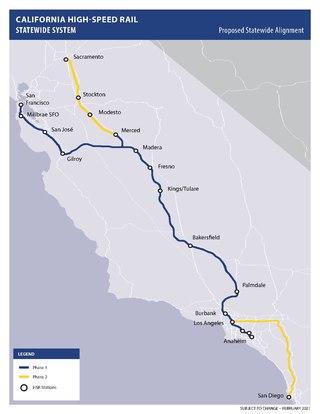
The California High-Speed Rail system will be built in two major phases. Phase I, about 520 miles (840 km) long using high-speed rail through the Central Valley, will connect San Francisco to Los Angeles. In Phase 2, the route will be extended in the Central Valley north to Sacramento, and from east through the Inland Empire and then south to San Diego. The total system length will be about 800 miles (1,300 km) long. Phase 2 currently has no timeline for completion.

The San Francisco and San Joaquin Valley Railroad was a California rail line between Stockton and Bakersfield constructed in the late 1890s and very shortly thereafter purchased by the Atchison, Topeka and Santa Fe Railroad and became their Valley Division.
The Stockton Diamond is a railway junction just south of downtown Stockton, California, near the intersection of Aurora Street South and East Scotts Avenue. It is the point where the north–south running Union Pacific Fresno Subdivision line crosses the east–west BNSF Stockton Subdivision, both double-track railways. Freight trains operate through the intersection 24 hours a day; Altamont Corridor Express and Amtrak California San Joaquins passenger trains also utilize the junction. Two of the sides of the "diamond" are complete and allow interchanges between the north-east and south-west legs.

The Stockton Subdivision is a railroad line in the U.S. state of California owned by the BNSF Railway. It runs from the Port of Richmond, where trains interchange with the Richmond Pacific Railroad, to Fresno where the railway continues south as the Bakersfield Subdivision or the Union Pacific Fresno Subdivision. The line was originally constructed by the San Francisco and San Joaquin Valley Railroad in the late 1890s before being acquired by the Atchison, Topeka and Santa Fe Railway and becoming its Valley Subdivision. BNSF spent $17.5 million to upgrade track, bridges, and crossings along the line in 2005.
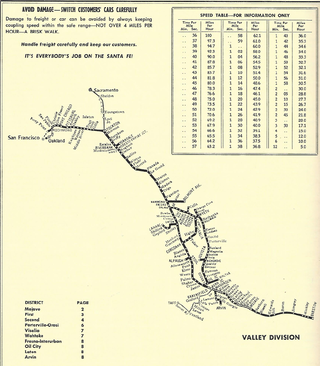
The Valley Division of the Atchison, Topeka and Santa Fe Railway ran from San Francisco to Barstow in California. It is currently in operation as the BNSF Railway's Stockton Subdivision and Bakersfield Subdivision.
The Fresno Subdivision is a railroad in California owned and operated by the Union Pacific Railroad. Mostly built by the Southern Pacific Railroad in the 1870s, the line traverses the San Joaquin Valley on a northwest to southeast alignment.

The Mojave Subdivision refers to a series of railway lines in California. The primary route crosses the Tehachapi Pass and features the Tehachapi Loop, connecting Bakersfield to the Mojave Desert. East of Mojave, the line splits with the Union Pacific Railroad portion continuing south to Palmdale and Colton over the Cajon Pass and the BNSF Railway owned segment running east to Barstow. Both companies generally share trackage rights across the lines.

















